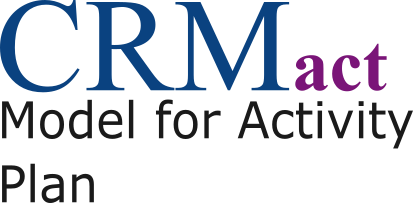|
What is the CRMact? CRMact defines the classes and properties which are necessary for integrating documentation records about plans for future activities and future events. The development of this extension follows discussions of the CIDOC-CRM SIG meetings on modelling legal rules and the application of laws as well as modelling treatment proposals for conservation of cultural heritage objects. The resulting model is a high level construct extending the CIDOC-CRM to handle documentation of projected future events with regards to their form and intention at the time of their projection and documentation. The main elements of this extension are the declaration and modelling of the classes and properties related to ‘Activity Plan’, ‘Event Template’ and ‘Intention to Apply’. |
What is the idea? The classes and properties of the CIDOC-CRM can be used to describe events that have taken place in the past. Such events are known to us through observation of the events or through observation of the material evidence that such events have produced. CIDOC-CRM classes and properties are not designed to describe future events because future events cannot be evidenced before they occur. Intuitively, we consider future events when expecting an event to occur (such as that the sun will set tonight) or when planning to engage in an activity (such as that I will organise a meeting). There is a variable degree of (un)certainty whether a projected future event will occur, which may depend on a) the consequence of an actor intending a projected future event to actually undertake or participate in that future event at the foreseen moment and/or b) factors outside of anyone’s control (force majeure). From the point of the present, when documentation of the projected future activity occurs, what is actually ontologically at hand is not an event but a conceptual description of what may happen. As such, future events can be described as instances of E89 Propositional Object. |


